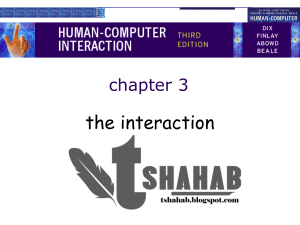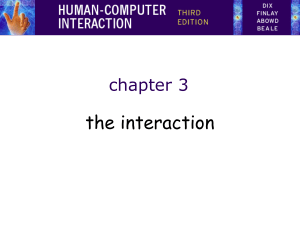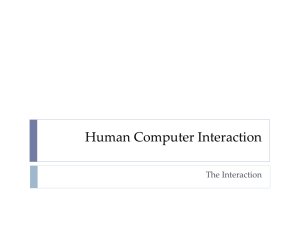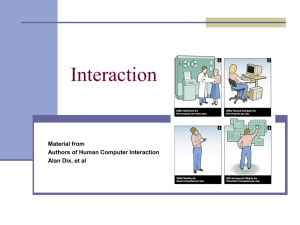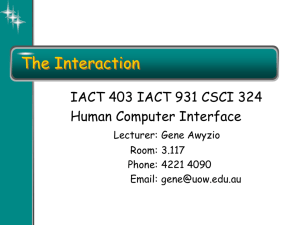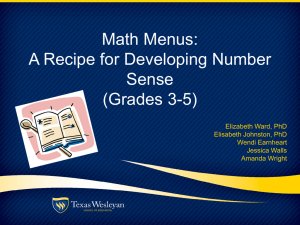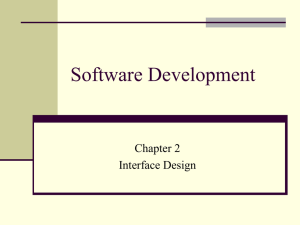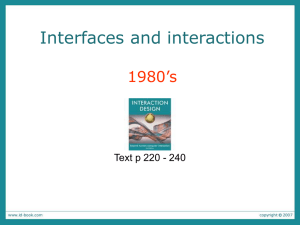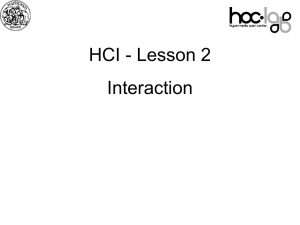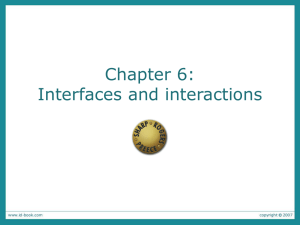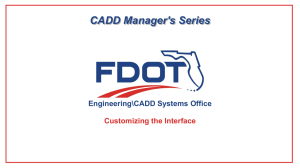Chapter 3 Slides
advertisement
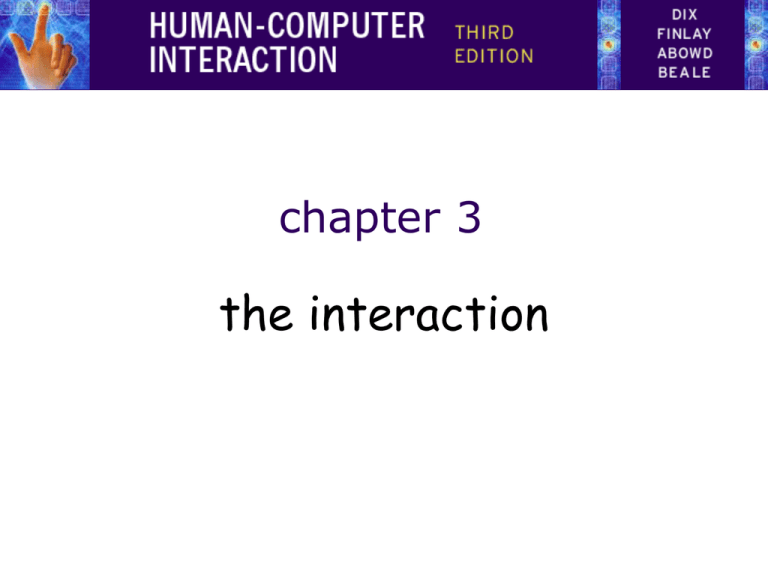
chapter 3 the interaction The Interaction • interaction models – translations between user and system • ergonomics – physical characteristics of interaction • interaction styles – the nature of user/system dialog • context – social, organizational, motivational What is interaction? communication user system but is that all … ? – see “language and action” in chapter 4 … models of interaction terms of interaction Norman model interaction framework Some terms of interaction domain – the area of work under study e.g. graphic design goal – what you want to achieve e.g. create a solid red triangle task – how you go about doing it – ultimately in terms of operations or actions e.g. … select fill tool, click over triangle Note … – traditional interaction … – use of terms differs a lot especially task/goal !!! Donald Norman’s model • Seven stages – – – – – – – user establishes the goal formulates intention specifies actions at interface executes action perceives system state interprets system state evaluates system state with respect to goal • Norman’s model concentrates on user’s view of the interface execution/evaluation loop goal execution evaluation system • • • • • • • user establishes the goal formulates intention specifies actions at interface executes action perceives system state interprets system state evaluates system state with respect to goal execution/evaluation loop goal execution evaluation system • • • • • • • user establishes the goal formulates intention specifies actions at interface executes action perceives system state interprets system state evaluates system state with respect to goal execution/evaluation loop goal execution evaluation system • • • • • • • user establishes the goal formulates intention specifies actions at interface executes action perceives system state interprets system state evaluates system state with respect to goal execution/evaluation loop goal execution evaluation system • • • • • • • user establishes the goal formulates intention specifies actions at interface executes action perceives system state interprets system state evaluates system state with respect to goal Using Norman’s model Some systems are harder to use than others Gulf of Execution user’s formulation of actions ≠ actions allowed by the system Gulf of Evaluation user’s expectation of changed system state ≠ actual presentation of this state Human error - slips and mistakes slip understand system and goal correct formulation of action incorrect action mistake may not even have right goal! Fixing things? slip – better interface design mistake – better understanding of system Abowd and Beale framework extension of Norman… their interaction framework has 4 parts – user – input S – system core – output O output U task I input each has its own unique language interaction translation between languages problems in interaction = problems in translation Using Abowd & Beale’s model user intentions translated into actions at the interface translated into alterations of system state reflected in the output display interpreted by the user general framework for understanding interaction – – – – not restricted to electronic computer systems identifies all major components involved in interaction allows comparative assessment of systems an abstraction ergonomics physical aspects of interfaces industrial interfaces Ergonomics • Study of the physical characteristics of interaction • Also known as human factors – but this can also be used to mean much of HCI! • Ergonomics good at defining standards and guidelines for constraining the way we design certain aspects of systems Ergonomics - examples • arrangement of controls and displays e.g. controls grouped according to function or frequency of use, or sequentially • surrounding environment e.g. seating arrangements adaptable to cope with all sizes of user • health issues e.g. physical position, environmental conditions (temperature, humidity), lighting, noise, • use of colour e.g. use of red for warning, green for okay, awareness of colour-blindness etc. Industrial interfaces Office interface vs. industrial interface? Context matters! type of data rate of change environment office textual slow industrial numeric fast clean dirty … the oil soaked mouse! Glass interfaces ? • industrial interface: – traditional … dials and knobs – now … screens and keypads • glass interface + cheaper, more flexible, multiple representations, precise values – not physically located, loss of context, complex interfaces • may need both Vessel B Temp 0 100 200 113 multiple representations of same information Indirect manipulation • office– direct manipulation – user interacts with artificial world system • industrial – indirect manipulation – user interacts with real world through interface interface • issues .. – feedback – delays immediate feedback instruments plant interaction styles dialogue … computer and user distinct styles of interaction Common interaction styles • • • • • • • • command line interface menus natural language question/answer and query dialogue form-fills and spreadsheets WIMP point and click three–dimensional interfaces Command line interface • Way of expressing instructions to the computer directly – function keys, single characters, short abbreviations, whole words, or a combination • • • • suitable for repetitive tasks better for expert users than novices offers direct access to system functionality command names/abbreviations should be meaningful! Typical example: the Unix system Menus • Set of options displayed on the screen • Options visible – less recall - easier to use – rely on recognition so names should be meaningful • Selection by: – numbers, letters, arrow keys, mouse – combination (e.g. mouse plus accelerators) • Often options hierarchically grouped – sensible grouping is needed • Restricted form of full WIMP system Natural language • Familiar to user • speech recognition or typed natural language • Problems – vague – ambiguous – hard to do well! • Solutions – try to understand a subset – pick on key words Query interfaces • Question/answer interfaces – user led through interaction via series of questions – suitable for novice users but restricted functionality – often used in information systems • Query languages (e.g. SQL) – used to retrieve information from database – requires understanding of database structure and language syntax, hence requires some expertise Form-fills • • • • Primarily for data entry or data retrieval Screen like paper form. Data put in relevant place Requires – good design – obvious correction facilities Spreadsheets • first spreadsheet VISICALC, followed by Lotus 1-2-3 MS Excel most common today • sophisticated variation of form-filling. – grid of cells contain a value or a formula – formula can involve values of other cells e.g. sum of all cells in this column – user can enter and alter data spreadsheet maintains consistency WIMP Interface Windows Icons Menus Pointers … or windows, icons, mice, and pull-down menus! • default style for majority of interactive computer systems, especially PCs and desktop machines Point and click interfaces • used in .. – multimedia – web browsers – hypertext • just click something! – icons, text links or location on map • minimal typing Three dimensional interfaces • virtual reality • ‘ordinary’ window systems – highlighting – visual affordance – indiscriminate use just confusing! flat buttons … click me! • 3D workspaces – use for extra virtual space – light and occlusion give depth – distance effects … or sculptured elements of the wimp interface windows, icons, menus, pointers +++ buttons, toolbars, palettes, dialog boxes also see supplementary material on choosing wimp elements Windows • Areas of the screen that behave as if they were independent – can contain text or graphics – can be moved or resized – can overlap and obscure each other, or can be laid out next to one another (tiled) • scrollbars – allow the user to move the contents of the window up and down or from side to side • title bars – describe the name of the window Icons • small picture or image • represents some object in the interface – often a window or action • windows can be closed down (iconised) – small representation fi many accessible windows • icons can be many and various – highly stylized – realistic representations. Pointers • important component – WIMP style relies on pointing and selecting things • uses mouse, trackpad, joystick, trackball, cursor keys or keyboard shortcuts • wide variety of graphical images Menus • Choice of operations or services offered on the screen • Required option selected with pointer File Edit Options Font Typewriter Screen Times problem – take a lot of screen space solution – pop-up: menu appears when needed Kinds of Menus • Menu Bar at top of screen (normally), menu drags down – pull-down menu - mouse hold and drag down menu – drop-down menu - mouse click reveals menu – fall-down menus - mouse just moves over bar! • Contextual menu appears where you are – pop-up menus - actions for selected object – pie menus - arranged in a circle • easier to select item (larger target area) • quicker (same distance to any option) … but not widely used! Menus extras • Cascading menus – hierarchical menu structure – menu selection opens new menu – and so in ad infinitum • Keyboard accelerators – key combinations - same effect as menu item – two kinds • active when menu open – usually first letter • active when menu closed – usually Ctrl + letter usually different !!! Menus design issues • which kind to use • what to include in menus at all • words to use (action or description) • how to group items • choice of keyboard accelerators Buttons • individual and isolated regions within a display that can be selected to invoke an action • Special kinds – radio buttons – set of mutually exclusive choices – check boxes – set of non-exclusive choices Toolbars • long lines of icons … … but what do they do? • fast access to common actions • often customizable: – choose which toolbars to see – choose what options are on it Palettes and tear-off menus • Problem menu not there when you want it • Solution palettes – little windows of actions – shown/hidden via menu option e.g. available shapes in drawing package tear-off and pin-up menus – menu ‘tears off’ to become palette Dialogue boxes • information windows that pop up to inform of an important event or request information. e.g: when saving a file, a dialogue box is displayed to allow the user to specify the filename and location. Once the file is saved, the box disappears. interactivity easy to focus on look what about feel? Speech–driven interfaces • rapidly improving … … but still inaccurate • how to have robust dialogue? … interaction of course! e.g. airline reservation: reliable “yes” and “no” + system reflects back its understanding “you want a ticket from New York to Boston?” Look and … feel • WIMP systems have the same elements: windows, icons., menus, pointers, buttons, etc. • but different window systems … behave differently e.g. MacOS vs Windows menus appearance + behaviour = look and feel Initiative • who has the initiative? old question–answer – computer WIMP interface – user • WIMP exceptions … pre-emptive parts of the interface • modal dialog boxes – come and won’t go away! – good for errors, essential steps – but use with care Error and repair can’t always avoid errors … … but we can put them right make it easy to detect errors … then the user can repair them hello, this is the Go Faster booking system what would you like? (user) I want to fly from New York to London you want a ticket from New York to Boston (user) no sorry, please confirm one at a time do you want to fly from New York (user) yes ……… Context Interaction affected by social and organizational context • other people – desire to impress, competition, fear of failure • motivation – fear, allegiance, ambition, self-satisfaction • inadequate systems – cause frustration and lack of motivation Experience, engagement and fun designing experience physical engagement managing value Experience? • home, entertainment, shopping – not enough that people can use a system – they must want to use it! • psychology of experience – flow (Csikszentimihalyi) – balance between anxiety and boredom • education – zone of proximal development – things you can just do with help • wider ... – literary analysis, film studies, drama Designing experience • real crackers – cheap and cheerful! – bad joke, plastic toy, paper hat – pull and bang Designing experience • virtual crackers – cheap and cheerful – bad joke, web toy, cut-out mask – click and bang Designing experience • virtual crackers – cheap and cheerful – bad joke, web toy, cut-out mask – click and bang how crackers work fill in web form sender receive email To: wxv From: .. recipient closed cracker page watches progress open recipient clicks cracker opens ... very slowly message open cracker page sender joke links mask web toy The crackers experience real cracker virtual cracker design cheap and cheerful simple page/graphics play plastic toy and joke web toy and joke dressing up paper hat mask to cut out shared offered to another sent by email message co-experience pulled together sender can't see content until opened by recipient excitement cultural connotations recruited expectation hiddenness contents inside first page - no contents suspense pulling cracker slow ... page change surprise bang (when it works) WAV file (when it works) Surface elements Experienced effects Physical design • many constraints: – – – – – – ergonomic – minimum button size physical – high-voltage switches are big legal and safety – high cooker controls context and environment – easy to clean aesthetic – must look good economic – … and not cost too much! Design trade-offs constraints are contradictory … need trade-offs within categories: e.g. safety – cooker controls front panel – safer for adult rear panel – safer for child between categories e.g. ergonomics vs. physical – MiniDisc remote ergonomics – controls need to be bigger physical – no room! solution – multifunction controls & reduced functionality Fluidity • do external physical aspects reflect logical effect? – related to affordance (chap 5) logical state revealed in physical state? e.g. on/off buttons inverse actions inverse effects? e.g. arrow buttons, twist controls inverse actions • yes/no buttons – well sort of • ‘joystick’ • also left side control spring back controls • one-shot buttons • joystick • some sliders good – large selection sets bad – hidden state a minidisk controller series of spring-back controls each cycle through some options –natural inverse back/forward twist for track movement pull and twist for volume – spring back – natural inverse for twist physical layout controls: logical relationship ~ spatial grouping compliant interaction state evident in mechanical buttons rotary knobs reveal internal state and can be controlled by both user and machine Managing value people use something ONLY IF it has perceived value AND value exceeds cost BUT NOTE • exceptions (e.g. habit) • value NOT necessarily personal gain or money Weighing up value value • helps me get my work done • fun • good for others cost • download time • money £, $, € • learning effort Discounted future • in economics Net Present Value: – discount by (1+rate)years to wait • in life people heavily discount – future value and future cost – hence resistance to learning – need low barriers and high perceived present value example – HCI book search • value for people who have the book helps you to look up things – chapter and page number • value for those who don’t … sort of online mini-encyclopaedia – full paragraph of context … but also says “buy me”!! … but also says “buy me”!! Value and organisational design • coercion • tell people what to do! • value = keep your job • enculturation • explain corporate values • establish support (e.g share options) • emergence • design process so that individuals value organisational value General lesson … if you want someone to do something … • make it easy for them! • understand their values
